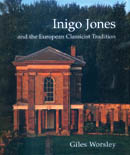Book review: Inigo Jones and the European Classicist Tradition
Jeremy Musson enjoys Giles Worsley's scholarly investigation into the work of one of the most influential English architects in the Classical tradition, published posthumously this year


Inigo Jones and the European Classicist Tradition
Giles Worsley (Yale, £40)
Inigo Jones has always been treated as a rare star of English architecture, a comet in a lonely sky. But as Giles Worsley argues in this first full length scholarly study of the work of Jones for 40 years, to northern Italians, Dutch and Germans 'Jones's work would have seemed part of the mainstream'. Dr Worsley explores the wider world of Classical design throughout these countries, thus providing not only the broader cultural context of Jones's work, but also a rare introduction to this period for an English audience.
Jones's own journey to Italy with the Earl and Countess of Arundel was 'the most momentous event in his life'.Dr Worsley traces his travels and conjectures on what contemporary buildings would have commanded his attention. After his return from Italy, Jones became Surveyor of the King's Works in 1615, a position he held, at the heart of English architecture, until deprived by the Common wealth, although he continued to design until shortly before his death in 1652.
Only six buildings known to be by him or which are commonly attributed to him survive. These are the Banqueting House at Whitehall; the Queen's Chapel at St James' Palace; Chevening House in Kent; the pavilions at Stoke Park; St Paul's Church, Covent Garden; and the Queen's House, Greenwich. Jones's contribution tends to be judged on these, and not on the lost buildings or more formidable unbuilt designs.
In this ambitious book, and in his typically well argued manner, and Dr Worsley has created a veritable march through Jones's career. This march becomes a brilliant investigation of the architectural language employed by Jones, from the hunting stable to the royal palace, to illustrate not just the use of Classical prototypes in detail, elevation and plan, but also in principle.
A key architectural value derived from ancient writing was the idea of decorum, which (in his stables, offices and smaller houses) also produced the simpler, symmetrical buildings with evenly spaced vertical rectangular openings, that became the foundation of what we think of as Georgian architecture. It is well known that, on his Italian tour, Jones did actually meet Vincenzo Scamozzi, the aged nephew of Andrea Palladio, the architect to whose name Jones will ever be linked, and Dr Worsley illustrates the use Jones made of his published work. He chooses not to explore the wider issues of Stuart Court patronage and Jones's role as a designer of Court masques, but to concentrate on his architectural career and legacy, which through this book we can now all look at afresh.
Exquisite houses, the beauty of Nature, and how to get the most from your life, straight to your inbox.
For instance, he argues forcefully that the portico and the Serliana (the tri-partite or 'Venetian' window) were used symbolically by Jones 'there was nothing "Palladian" about Jones's use of the Serliana. It needs to be read as a powerful symbol of sovereignty, as indeed does the whole palace of Whitehall'. Anyone who has an interest in the Classical tradition of architecture, or the history of England in the 17th century a period which defined so many of our national institutions should read this thoughtful and well argued study.
The cover itself depicts a beautifully lit view of one of the brilliantly advanced pavilions at Stoke Park, taken by Paul Barker, for one of Dr Worsley's last articles for Country Life, in which some of these ideas were first explored.
Country Life is unlike any other magazine: the only glossy weekly on the newsstand and the only magazine that has been guest-edited by His Majesty The King not once, but twice. It is a celebration of modern rural life and all its diverse joys and pleasures — that was first published in Queen Victoria's Diamond Jubilee year. Our eclectic mixture of witty and informative content — from the most up-to-date property news and commentary and a coveted glimpse inside some of the UK's best houses and gardens, to gardening, the arts and interior design, written by experts in their field — still cannot be found in print or online, anywhere else.
